Eduard 1/48 F6F-3 Hellcat
|
KIT: |
Eduard 1/48 F6F-3 Hellcat |
|
KIT #: |
8221 |
|
PRICE: |
$34.95 MSRP |
|
DECALS: |
Five options |
|
REVIEWER: |
Tom Cleaver |
|
NOTES: |
|
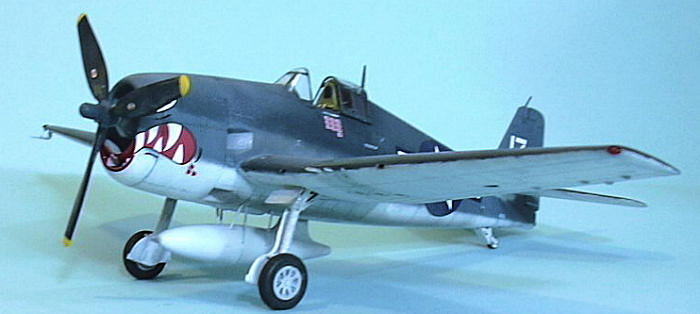
The F6F‑3/5 Hellcat is the most
successful naval fighter series ever built.
With pilots of moderate training
levels, the airplane could more than hold its own against its opponents, while
it was tractable enough that the same moderately‑trained pilot could bring a
damaged one back and get aboard his carrier, a point of no small importance in
naval warfare.
It is the only fighter of the
Second World War to remain essentially unchanged in basic design from its
introduction to service to its post‑war withdrawal, with the main difference
between the two production variants being engine power.
The Myth of the Hellcat:
To straighten out the myth of the
airplane, the Hellcat was
not produced "in answer" to the Japanese Zero, which would be its
major wartime opponent; it would have been impossible to design
an airplane starting in 1942 (following the discovery of the Zero in the
Aleutians that August) that would have had any hope of
getting into production in the required timescale.
The Hellcat
was already in preliminary design stages well before the outbreak
of the Pacific War, and first flew about the time of the Battle
of Midway.
What was indeed fortunate was that
both Grumman and
the "Fighter Desk" of the U.S. Navy's Bureau of Aeronautics had
paid attention to what was going on in Europe with regards to air
combat.
They guessed right in giving the
Hellcat the biggest
wing of any Second World War fighter for maneuverability, and the
largest ammunition capacity, to improve its ability
as a fleet defense fighter.
They were fortunate that the
airframe was amenable to initial change from the underpowered R‑2600 to the
far‑superior R‑2800, the finest radial piston engine ever built. With this
engine, the airplane had sufficient power to outfly its opposition.
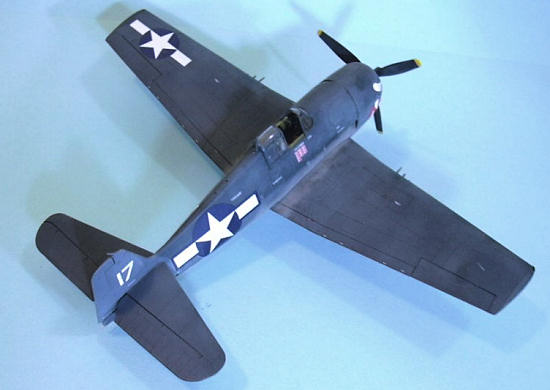 The Hellcat first entered combat in
the fall of 1943, as the
Navy was beginning the Central Pacific Offensive, with squadrons
based aboard both the big "Essex" class fleet carriers, and the
"Independence" class light carriers which were based on cruiser
hulls.
The U.S. Navy was the only air
force of the Second World
War to insure its fighter pilots went into combat knowing what to
do both with their airplanes and their weapons.
With this
superior gunnery training, many Hellcat pilots became an “ace in
a day" in the swirling air battles that began over Truk in early
1944, and then moved on across the Central Pacific with the
invasions of the Marshalls and Marianas later that year.
(To be fair and balanced, it should be mentioned that the quality of Japanese
training by this time of the war was substantially inferior and the quality of
most pilots met by US airmen was equally as substandard. One cannot denigrate
the bravery of Japanese pilots of the time, just their experience and training.
Ed)
The Hellcat first entered combat in
the fall of 1943, as the
Navy was beginning the Central Pacific Offensive, with squadrons
based aboard both the big "Essex" class fleet carriers, and the
"Independence" class light carriers which were based on cruiser
hulls.
The U.S. Navy was the only air
force of the Second World
War to insure its fighter pilots went into combat knowing what to
do both with their airplanes and their weapons.
With this
superior gunnery training, many Hellcat pilots became an “ace in
a day" in the swirling air battles that began over Truk in early
1944, and then moved on across the Central Pacific with the
invasions of the Marshalls and Marianas later that year.
(To be fair and balanced, it should be mentioned that the quality of Japanese
training by this time of the war was substantially inferior and the quality of
most pilots met by US airmen was equally as substandard. One cannot denigrate
the bravery of Japanese pilots of the time, just their experience and training.
Ed)
Striking across the breadth of the
Pacific against Okinawa,
Formosa, Indochina and the Philippines during the summer and
fall of 1944, Hellcats shot down everything they
ran across.
From their first introduction into
combat in the summer of 1943 through August 15, 1945, U.S. Navy Hellcats shot
down over 5,000 enemy aircraft, and over 300 Hellcat pilots achieved ace status
while flying the airplane.
Truly, it was an "ace maker".
VF-27 At Leyte Gulf:
The only organization more
encrusted with the barnacles of seniority than the United States Navy is the
Royal Navy.
During the Second World War, there
was a definite “pecking order” within carrier aviation: the fleet carriers and
their associated squadrons; the light carriers and their associated squadrons;
the escort carriers and their associated squadrons.
The light fleet carriers were
looked down on from the flight decks of the “Essex” fleet carriers as “jury
rigs.”
All squadrons were commanded by
“ring knockers” - Naval Academy Graduates - and all command positions above
Division Leader were reserved for the Academy boys, regardless of whether the
Reservists they commanded were (generally) more experienced pilots, and higher
scorers.
This was particularly true by 1944.
This sort of snobbery was
maintained in the assignments to various squadrons, with those assigned to the
CVLs being commanded by Academy graduates who were lower on the pecking order
with regard to seniority - from standing in their graduating class to date of
promotion.
Given this state of affairs, it is
interesting that one of the most successful Navy fighter squadrons was VF-27,
which flew from the U.S.S. Princeton.
One of the first CVLs to enter
combat, Princeton had operated with USS Essex
from the first fast carrier raids against Wake Island in August 1943,
participating in the November 11 1943 raid on Rabaul, the Gilberts campaign, the
Truk Raids, the Marshalls campaign, the “Marianas Turkey Shoot” during the
invasion of the Marianas, the Central Pacific raids and the Formosa raids before
taking part in her final operation, the invasion of the Philippines and the
Battle of Leyte Gul.
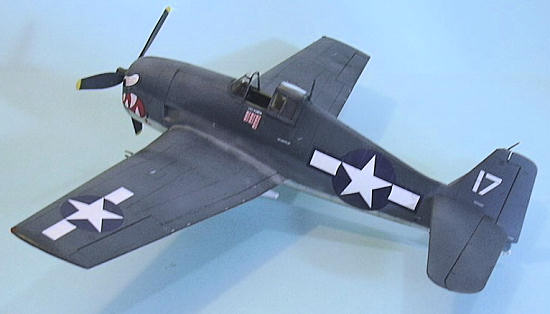 VF-27, formed in Hawaii in early
1944, was commanded by LCDR Fred Bardshar.
Among the experienced pilots
assigned as cadre to the new squadron was Lt. (jg) Richard E. Stambrook, who had
flown at the Battle of the Eastern Solomons with VS-3 aboard
Saratoga, moving on to flying
Wildcats and later Hellcats with VF-3 where he was trained by LCDR Edward O.
“Butch” O'Hare; VF-3 became VF-6 aboard USS Intrepid.
Stambrook came to VF-27 with a
score of 2 accomplished during the first Truk raid in January 1944.
VF-27, formed in Hawaii in early
1944, was commanded by LCDR Fred Bardshar.
Among the experienced pilots
assigned as cadre to the new squadron was Lt. (jg) Richard E. Stambrook, who had
flown at the Battle of the Eastern Solomons with VS-3 aboard
Saratoga, moving on to flying
Wildcats and later Hellcats with VF-3 where he was trained by LCDR Edward O.
“Butch” O'Hare; VF-3 became VF-6 aboard USS Intrepid.
Stambrook came to VF-27 with a
score of 2 accomplished during the first Truk raid in January 1944.
Bardshar was something of an
eccentric among Academy grads.
He was not a totally “by the book”
leader.
When he found out that one of his
Naval Reservists pilots, Lt (jg) Robert Burnell, was an accomplished artist, he
asked Burnell to come up with a distinctive squadron marking (a definite no-no
on the big fleet carrier squadrons), as a way of promoting unit morale.
Burnell came up with a play on the
airplane's name: Hell Cat, with bloodshot eyes and dripping fangs in a blood red
mouth.
When VF-27 arrived aboard
Princeton in late August 1944,
just before the Formosa raids that would lead to the Philippines invasion, VF-27
was flying the most distinctively-marked Hellcats to ever go aboard a Navy
carrier.
The unit quickly demonstrated the
value of Bardshar's emphasis on gunnery training in swirling combats over
Formosa and northern Luzon in September and early October, 1944.
By October 18, 1944, when he downed
a “Nick,” Dick Stambrook was the unit's leading ace with 11 kills.
October 24, 1944 was both the high
and the low of VF-27's career. Princeton
was operating with Essex,
Lexington, and
Langley as Task Group 38.3
under command of RADM Forrest Sherman.
Lexington
was additionally the flagship of VADM Marc Mitscher, commanding Task Force 38.
Two VF-27 flights - one commanded
by “Red” Shirley and the other by Carl Brown - were launched just before dawn,
as the task force radars showed much enemy aerial activity over the gulf and the
island of Leyte.
Essex,
Lexington and
Langley also launched all
available fighters to meet the threat.
First Shirley's and then Brown's
divisions were vectored to intercept snoopers, which turned out to be “Nicks”
and were quickly dispatched.
As dawn broke fully over Leyte
Gulf, the two divisions were vectored onto a large enemy formation inbound.
Shirley's division was first to
spot them.
Shirley reported: “Tally-ho.
80 Japs.
Better send help.”
In a swirling dogfight, the eight
“Hell Cats” shot down a total of 34 of 36 Japanese aircraft - 14 by Shirley's
division and the remainder by Brown's.
Out of ammo and low on fuel, the
eight Hellcats returned to Princeton
to refuel and rearm.
The deck crews scrambled to refuel
and rearm their defenders. Brown's division was finished first and launched.
Stambook's division was brought up from the hangar on the after elevator while
the deck crew turned to Shirley's division, pushing them into position for
launch.
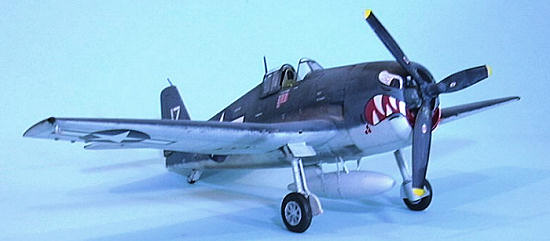 At 0939, just as the second Hellcat
was spotted for launch, a lone Judy dive bomber appeared out of the clouds and
dropped a 250-kg bomb, striking Princeton
on the flight deck just aft of amidships.
At 0939, just as the second Hellcat
was spotted for launch, a lone Judy dive bomber appeared out of the clouds and
dropped a 250-kg bomb, striking Princeton
on the flight deck just aft of amidships.
The bomb penetrated the unarmored
flight deck and exploded in the crew's galley after passing through the hangar.
Six TBM bombers, each with full
gasoline tanks and a torpedo were in the hangar awaiting movement to the flight
deck for launch, and one was struck by the bomb and immediately caught fire.
The firefighting sprinklers failed
to activate and the entire hangar was quickly engulfed in fire, while smoke
penetrated the compartments below.
At 1002 a heavy explosion rocked
the after part of the hangar, followed by three more internal explosions which
destroyed the flight deck, blew out both aircraft elevators and spread fire
throughout Princeton.
Disaster now piled atop disaster.
Princeton
now had only
emergency generator power gone, and
many of the crew were in the water, forced to abandon ship to get away from the
fires.
USS
Morrison (DD-560), came alongside to help fight
fires. The flight deck overhang was now a deadly weapon as
Princeton wallowed, helpless.
Morrison
became entangled in the overhang and her forward superstructure was seriously
damaged.
She was forced to break off rescue
attempts as another enemy raid was reported inbound.
At this point, after nearly three
hours work, the fires were nearly under control on
Princeton.
In the second raid,
Princeton was hit again.
This time, the fires heated a bomb
storage space in the aft hangar. As the surviving Japanese were chased off by
the defending CAP, the light cruiser USS Birmingham
(CL-62) came alongside to provide fire fighting capability and to take off the
remaining survivors.
At 1523, the bombs in storage
detonated violently, blowing off
Princeton's stern and
showering Birmingham
with fragments.
229
Princeton survivors being treated on the open decks,
as well as crewmen of Birmingham,
were killed in the catastrophe, along with 420 wounded, a greater loss of life
than resulted from the original attack on Princeton.
There was now no hope of saving
Princeton. Her remaining
crew were taken off and USS Irwin
attempted to scuttle her with torpedoes and gunfire without success. Finally,
the light cruiser USS Reno
was ordered to finish the job. One of her torpedoes hit near the forward bomb
magazine.
A fireball rose 1,000 feet above
the sea and Princeton
disappeared in a tremendous explosion at 1803.
She was the only American fleet
carrier sunk by enemy action after the Battle of Santa Cruz, in which the first
Hornet was lost. 10
officers and 98 enlisted men had been lost, but 1,361 crewmen survived.
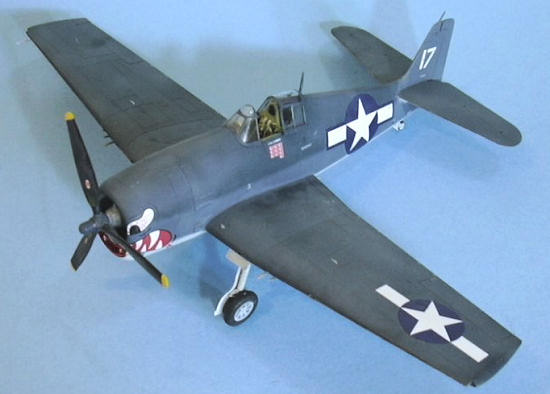 After his launch from
Princeton, Carl Brown and his
division became involved in another swirling fight to save the task force.
Brown ended the fight pursued by
four Zekes, badly wounded.
He managed to out-dive the enemy
and returned to the task force.
His Hellcat, “Paper Doll,” was
later found to have been hit 184 times. Brown managed to land “Paper Doll”
aboard Essex after being
refused by Lexington and
Langley which were both
afraid of him fouling their decks.
A Navy photographer caught “Paper
Doll” at the moment of touchdown on Essex,
with the burning Princeton
in the background, which became one of the most famous photos of the war.
After his launch from
Princeton, Carl Brown and his
division became involved in another swirling fight to save the task force.
Brown ended the fight pursued by
four Zekes, badly wounded.
He managed to out-dive the enemy
and returned to the task force.
His Hellcat, “Paper Doll,” was
later found to have been hit 184 times. Brown managed to land “Paper Doll”
aboard Essex after being
refused by Lexington and
Langley which were both
afraid of him fouling their decks.
A Navy photographer caught “Paper
Doll” at the moment of touchdown on Essex,
with the burning Princeton
in the background, which became one of the most famous photos of the war.
A
total of nine VF-27 Hellcats had been airborne when Princeton was hit, and all
landed aboard Essex.
That night, the nine Hell Cats were press-ganged into VF-15.
After a night with paint brushes,
the Hell Cats were once again merely Hellcats.
VF-27 ceased to exist. In just over
seven weeks of operations, the squadron had scored 200 victories, making it the
top-scoring CVL fighter squadron of the war.
There have been several 1/48 scale
F6F Hellcats released over the past 50 years, starting with one from Lindbergh
and one from Aurora in the mid-1950s, while Monogram released one in about 1963
that was more toy than model, with provision for folding wings.
In 1971, Otaki released a Hellcat
that was basically a mid-production F6F-3, that was light years ahead of its
contemporaries and still can be made up into a very credible model as both an
F6F-3 or an F6F-5 with suitable modification.
Hasegawa released the F6F-3 and
F6F-5 about ten years ago, which provided a nice cockpit that was difficult to
see since the canopy could only be accurately posed in the open position if the
modeler used a Falcon vacuform canopy, though the kit was marred by a cowling of
incorrect profile shape.
Many modelers wondered why Eduard
would do a Hellcat when two different good models were already available.
After studying this kit, I can say
that they did it for the same reason they released a series of Fw-190s in 1/48:
their product is superior.
The kit has surface detail that is
superior to either the Otaki or Hasegawa kits, with very petite engraved rivet
detail along panel lines, and separate control surfaces that can be posed
dynamically.
The kit includes a nicely-detailed
cockpit in plastic, which is accompanied by very good pre-painted photo-etch
detail for the cockpit that is up to Eduard's usual standards.
Cowlings for the early-production,
mid-production, and late-production F6F-3 are provided.
Decals are provided for no less
than five F6F-3s, including “Gadget,” flown by aces Alex Vraciu of VF-6, and the
“Hell Cat” of LT Richard Stambook of VF-27.
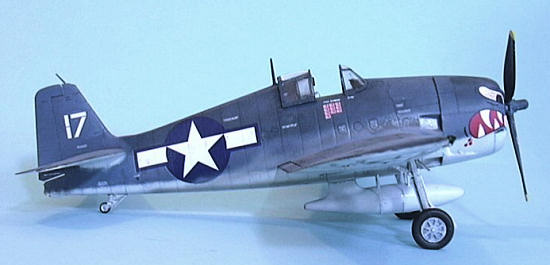 There has been the usual
brew-ha-ha regarding the release of this kit among those with too much time on
their hands over at The Other Place, regarding the accuracy of the kit in
general and the “grin” in particular.
In his comprehensive review of the
kit, Brett Green points out that of the available Hellcat cowlings - both those
from kits and those from aftermarket producers - none is entirely accurate,
though some are moreso than others, concluding that the Eduard cowling is
overall the most accurate.
This is also the conclusion that
has been drawn after copious study of photo comparisons between actual Hellcats
and the kit, from those participating in the commentary Over There.
There has been the usual
brew-ha-ha regarding the release of this kit among those with too much time on
their hands over at The Other Place, regarding the accuracy of the kit in
general and the “grin” in particular.
In his comprehensive review of the
kit, Brett Green points out that of the available Hellcat cowlings - both those
from kits and those from aftermarket producers - none is entirely accurate,
though some are moreso than others, concluding that the Eduard cowling is
overall the most accurate.
This is also the conclusion that
has been drawn after copious study of photo comparisons between actual Hellcats
and the kit, from those participating in the commentary Over There.
There has also been comment about
the rivet detail on the kit.
While I generally side with those
who believe rivet detail in 1/48 is likely to be overdone and therefore best not
done, the rivet detail here is as petite as that which appears on the Eduard
Fw-190s.
It is also a nice representation of
the rivet detail I have seen on the 1:1 Hellcats that live out at Planes of
Fame.
I particularly like that the
canopies are thin enough that they can be posed in the open position, since this
is likely the best-detailed cockpit of any Hellcat kit, including the
aftermarket resin cockpits that have been released over the years.
There is some deserved criticism of
the kit regarding the landing gear.
The wheels do appear to be too
narrow in cross section to be right for anything other than the very early
production version.
This can be solved be either buying
some resin wheels, or gluing some 15-mil sheet styrene between the wheel halves
and wielding a sanding stick for a few minutes.
Also, the gear legs to appear to be
a bit long - not inaccurately, but rather they are too high for an airplane with
a full load of gas and ammo.
Those who want to worry about this
can easily trim down the oleo leg with a very modest application of “some
modeling skill required.”
The decals are very nice, with the
insignias the proper size and dimensions and color.
The white numbers appear to be
sufficiently opaque that they will go over the blue colors without problem.
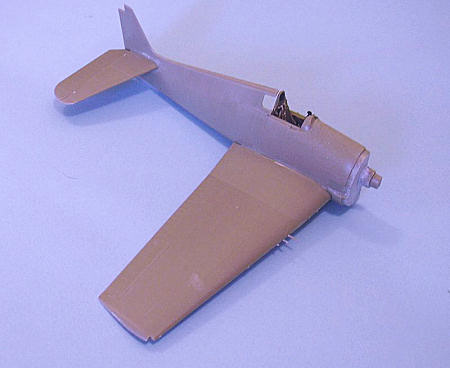 The Hellcat is basically a simple
model to build overall, in any kit from any manufacturer, and the Eduard kit is
no exception.
The Hellcat is basically a simple
model to build overall, in any kit from any manufacturer, and the Eduard kit is
no exception.
As designed, the separate control
surfaces are not posable, though they do provide separation of these surfaces
from the main airframe.
Other than that, I cannot see why
the kit was designed this way, particularly since the Hellcat had a
spring-loaded stick, so that the controls were never “dynamically posed” while
the airplane was on the ground to begin with.
I assembled the wings and tail
surfaces and then attached them to the fuselage halves before assembling the
fuselage, because this allowed me to work the connections from inside and out
and get them fully seated, which I think is necessary given the design for
attaching the wings and tail.
Personally, I think Hasegawa got it
right with a one-piece lower wing that attached to the fuselage along panel
lines, which insured getting the proper dihedral to the wing.
The cockpit is perhaps the simplest
Hellcat cockpit I have seen from any kit since the Otaki release.
That said, with the use of the
photoetch, what one sees in the end with the fuselage
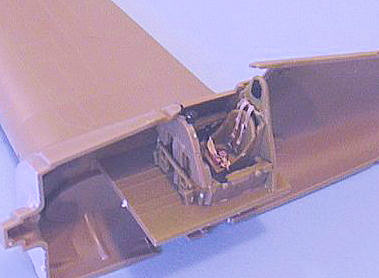 assembled
and the cockpit closed up is quite acceptable; much of the detail of the
more-detailed Hasegawa kit cockpit, or the True Details resin cockpit, isn't all
that visible in the final result.
assembled
and the cockpit closed up is quite acceptable; much of the detail of the
more-detailed Hasegawa kit cockpit, or the True Details resin cockpit, isn't all
that visible in the final result.
I needed to run some cyanoacrylate
glue along the fuselage centerline seam, but that was the only place the kit
needed help.
The engine assembles easily and
looks right once it is inside the cowling.
The cowling parts fit perfectly,
and I only needed some cyanoacrylate glue along the lower center seam to smooth
that out.
Overall, assembly of the model
occupied less than two hours, including time spent waiting for the paint to dry
- I did pre-paint the cockpit parts interior green and the cowling interior
light grey, using the Aerohobby Acrylics which go on easily since they are
pre-mixed thin enough to airbrush out of the container without additional
thinning.
I painted the engine cylinders
Tamiya Flat Aluminum, then hand-painted with Tamiya “Smoke” to pop out detail.
Painting:
This time, given the colors I was
going to paint the model, I did the “pre-shading” with Tamiya Dark Grey rather
than Flat 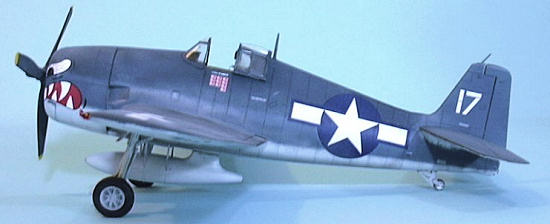 Black,
since it wouldn't take so much of the final colors to go over it.
I wanted to be sure to use only a
thin coat of paint overall to keep the very nice surface detail visible.
The tri-color scheme was done with
Gunze paints: Gunze “Navy White” for the lower surfaces (a slightly off-white
color), Intermediate Blue and Navy Blue.
Black,
since it wouldn't take so much of the final colors to go over it.
I wanted to be sure to use only a
thin coat of paint overall to keep the very nice surface detail visible.
The tri-color scheme was done with
Gunze paints: Gunze “Navy White” for the lower surfaces (a slightly off-white
color), Intermediate Blue and Navy Blue.
Decals:
I finally decided to do Jim
Stambrook's “Hell Cat” from VF-27 after thinking about doing the well-known
“Gadget” since I have met Alex Vraciu.
However, I finally concluded that
Eduard had finally come up with the best “face” decals for a VF-27 F6F-3 (when
the face was more detailed than on the later F6F-5s).
I will likely do “Gadget” at some
point in the future. The Eduard decals went down without problem, using
Micro-Sol to soften them.
Navy airplanes at sea do not have a
lot of metallic “dings” because they cannot survive in a saltwater environment
if they are left in that condition.
So my weathering was limited to
getting the upper surfaces really flat, so it looked like the airplane had been
under the tropic sun and in a saltwater environment for several months as it had
by October 1944.
It is said that the upper color
paints in the tri-color scheme were so prone to sun-fading and saltwater
corrosion that by the end of a West Pad cruise the paint looked like chalk on
the airplanes; this is why the Navy went to Glossy Sea Blue.
After getting a really flat finish
by mixing in some Tamiya “Flat Base” to the Xtracrylix “Flat” varnish, I applied
some strong exhaust staining and some gun residue staining, since photos of
Hellcats show both to have been present nearly all the time. I then attached the
landing gear and prop and attached the canopy in the open position.
So, how good is the Eduard Hellcat?
Those modelers who have Otaki or
Hasegawa kits in their stash certainly have no more need of throwing them away
in the face of this newer release than did the owners of Tamiya, DML or Hasegawa
Fw-190s when those newer Eduard kits were released.
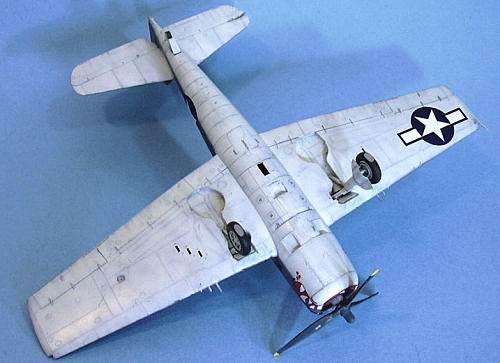 On a personal level, I like the
Eduard kit's surface detail the best, closely followed by that of the old Otaki
kit and last by Hasegawa.
The Otaki kit has the worst design
for attaching the wings to the fuselage of the three. The Otaki and Hasegawa
kits have better props.
The Hasegawa kit has a better
cockpit straight out of the box, unless one is set on having the Eduard
photoetch instrument panel or uses the more complete Eduard cockpit interior
photoetch fret available separately, though the Hasegawa instrument panel decal
is fine to me.
Both the Hasegawa and Otaki kits
need the Squadron/Falcon vacuform canopies if the canopy is to be posed open,
while the Eduard kit doesn't.
The Otaki kit needs the True
details cockpit, while the Hasegawa kit needs the Obscureco resin cowling. Both
need a separate decal sheet.
On a personal level, I like the
Eduard kit's surface detail the best, closely followed by that of the old Otaki
kit and last by Hasegawa.
The Otaki kit has the worst design
for attaching the wings to the fuselage of the three. The Otaki and Hasegawa
kits have better props.
The Hasegawa kit has a better
cockpit straight out of the box, unless one is set on having the Eduard
photoetch instrument panel or uses the more complete Eduard cockpit interior
photoetch fret available separately, though the Hasegawa instrument panel decal
is fine to me.
Both the Hasegawa and Otaki kits
need the Squadron/Falcon vacuform canopies if the canopy is to be posed open,
while the Eduard kit doesn't.
The Otaki kit needs the True
details cockpit, while the Hasegawa kit needs the Obscureco resin cowling. Both
need a separate decal sheet.
However, those in search of the
Seven Cities of Cibola, El Dorado's gold, Captain Kidd's treasure, the Amber
Room, or the perfect model kit will continue to be disappointed.
The Eduard Hellcat does not signify
the arrival of Modeler's Nirvana.
All that said, while the Otaki and
Hasegawa Hellcats are good kits that can form the basis of nice models, any
modeler who wants to “get it right” will have to purchase aftermarket decals and
various resin bits as listed above.
The Eduard Hellcat gives a modeler
everything they need: the different cowlings for the different production
versions, a detailed-enough cockpit, and interesting, well-produced decals.
The Hellcat is one of my favorite
Navy fighters, and this kit provides a very good basis for the creation of an
excellent model.
Highly recommended.
Thanks
for Eduard for the review kit.
Tom Cleaver
July 2008
If you would like your product reviewed fairly and quickly, please
contact
me or see other details in the
Note to
Contributors.
Back to the Main Page
Back to the Review
Index Page


 The Hellcat first entered combat in
the fall of 1943, as the
The Hellcat first entered combat in
the fall of 1943, as the

 After his launch from
Princeton, Carl Brown and his
division became involved in another swirling fight to save the task force.
Brown ended the fight pursued by
four Zekes, badly wounded.
He managed to out-dive the enemy
and returned to the task force.
His Hellcat, “Paper Doll,” was
later found to have been hit 184 times. Brown managed to land “Paper Doll”
aboard Essex after being
refused by Lexington and
Langley which were both
afraid of him fouling their decks.
A Navy photographer caught “Paper
Doll” at the moment of touchdown on Essex,
with the burning Princeton
in the background, which became one of the most famous photos of the war.
After his launch from
Princeton, Carl Brown and his
division became involved in another swirling fight to save the task force.
Brown ended the fight pursued by
four Zekes, badly wounded.
He managed to out-dive the enemy
and returned to the task force.
His Hellcat, “Paper Doll,” was
later found to have been hit 184 times. Brown managed to land “Paper Doll”
aboard Essex after being
refused by Lexington and
Langley which were both
afraid of him fouling their decks.
A Navy photographer caught “Paper
Doll” at the moment of touchdown on Essex,
with the burning Princeton
in the background, which became one of the most famous photos of the war.

 assembled
and the cockpit closed up is quite acceptable; much of the detail of the
more-detailed Hasegawa kit cockpit, or the True Details resin cockpit, isn't all
that visible in the final result.
assembled
and the cockpit closed up is quite acceptable; much of the detail of the
more-detailed Hasegawa kit cockpit, or the True Details resin cockpit, isn't all
that visible in the final result. Black,
since it wouldn't take so much of the final colors to go over it.
I wanted to be sure to use only a
thin coat of paint overall to keep the very nice surface detail visible.
The tri-color scheme was done with
Gunze paints: Gunze “Navy White” for the lower surfaces (a slightly off-white
color), Intermediate Blue and Navy Blue.
Black,
since it wouldn't take so much of the final colors to go over it.
I wanted to be sure to use only a
thin coat of paint overall to keep the very nice surface detail visible.
The tri-color scheme was done with
Gunze paints: Gunze “Navy White” for the lower surfaces (a slightly off-white
color), Intermediate Blue and Navy Blue.
